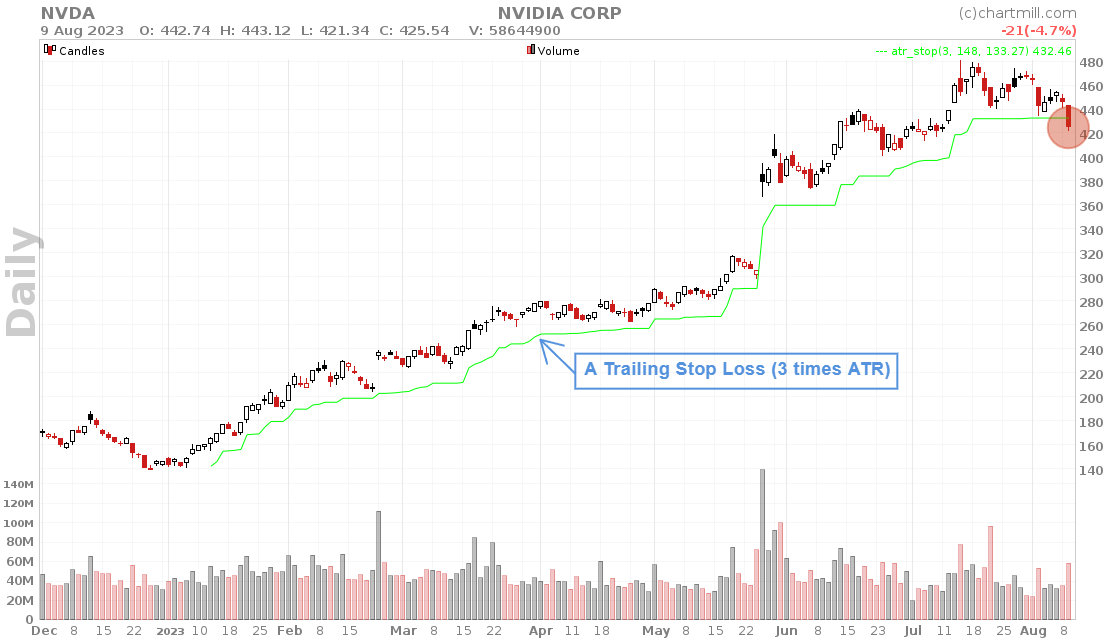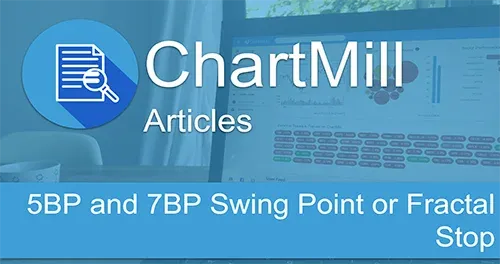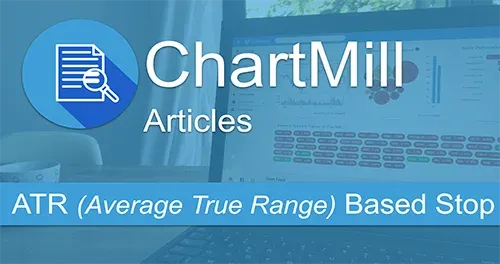Trailing Stop Loss: Safeguarding Your Investments While Maximizing Winners!
By Kristoff De Turck - reviewed by Aldwin Keppens
~ 5 minutes read - Last update: Apr 19, 2024
In the ever-evolving world of financial markets, safeguarding your investments is paramount. One of the most effective tools in a trader's toolkit is the trailing stop loss order type.
Such a stop is set at a predefined distance from the market price of a security. In the case of a long position, this stop will rise as the stock price of the underlying asset rises. In this way, an increasing portion of open profits is protected.
In the case of a short position, the stop is located above the market price and decreases along with it as the price of the stock decreases and the profit with this short position gets larger.
The bottom line is to stay in the market as long as possible, locking in profits as the price continues to rise.
Essential Insights
-
A trailing stop loss is a dynamic stop that adjusts automatically based on an asset's price movement.
-
It aims to protect profits by maintaining a certain distance or percentage from the current market price. In this way, it captures maximum gains by riding upward price momentum.
-
This stop loss rises along with the price and thus protects an increasing portion of accumulated profits.
-
It provides flexibility, adaptability, and emotion-free execution.
This kind of stop loss is a specific dynamic risk management technique that involves setting an automatic sell order that adjusts itself based on the asset's price movement. Unlike traditional stop loss orders, which remains fixed, this stop "trails" the price movement by a certain percentage or amount.
This means that as the asset's price increases, the stop loss price is adjusted upward, ensuring potential profits are protected. The stop can only rise, never fall.
Why Use a Trailing Stop Loss?
Implementing this specific stop loss offers several key advantages:
1. Capitalizing on Market Momentum
It allows investors to ride the upward momentum of an asset. As the price climbs, the stop loss is adjusted higher, enabling traders to capture maximum gains without the risk of sudden reversals erasing profits.
2. Minimizing Losses
During market declines, this stop helps minimize losses by automatically selling the asset if the price falls below the trailing distance. This shields investors from significant downturns.
3. Flexibility and Adaptability
A trailing stop adapts to the asset's price movement, providing flexibility in volatile markets. It ensures that you stay invested as long as the uptrend continues, while still securing profits in case of a sudden reversal.
4. Emotion-Free Execution
Human emotions can cloud judgment and lead to impulsive decisions. Using a trailing stop eliminates emotional trading, as the strategy is pre-defined and executed automatically.
Best Practices
The difficulty with a such a stop loss is determining the distance between the stop and the market price of the security in which one has an open position. A stop loss that is too tight will cause the position to be stopped out (much) too soon because it does not take into account the volatility of the price.
Likewise, a stop loss that is too far away is disadvantageous because accumulated profits are in danger of disappearing again. Finding the balance between allowing sufficient room to move on the one hand and protecting profits on the other is by no means a simple task.
Understanding Volatility
A trailing stop loss takes into account the asset's volatility by adjusting the stop loss level based on a predetermined percentage or amount. In times of high volatility, the stop loss is set further away from the current price, allowing the asset more room to maneuver.
However, it's important to note that this stop only moves in one direction - upward - it does never move backward. When the volatility of an asset increases, this stop will rise at a slower pace. This mechanism helps to account for the heightened price fluctuations associated with higher volatility.
The purpose behind this slower adjustment is to prevent premature triggering of the sell order due to minor price drops that are common in volatile markets. By rising less quickly, it provides the asset with a broader range of movement, allowing it to navigate through temporary fluctuations without prematurely exiting the trade.
If the asset's price reverses and starts to decline, this stop remains at its highest achieved level. This means that if the price reaches back to the trailing level, the asset will be sold, securing the profits captured during the uptrend.
This measured approach to adjusting the stop helps traders strike a balance between protecting profits and allowing the asset to capture potential gains during periods of heightened volatility. It's a strategic feature that reflects the adaptive nature of the trailing stop loss, ensuring that it remains effective across a range of market conditions.
How A Trailing Stop works
Choosing an optimal trailing distance that aligns with the asset's typical price fluctuations involves a thoughtful and strategic approach that takes into account both the asset's price movement patterns and your risk tolerance. The trailing distance determines how closely the stop loss follows the rising price of the asset.
There are several ways to set the trailing distance:
1. A Percentage of the Asset Price
Depending on the investment horizon and strategy, a percentage between 1% and 5% is set.
2. A Fixed Dollar Amount
Suppose the stock is trading at $22, you may choose to set a stopping distance of 1$ (4.5%). Keep in mind that the distance of $1 is different for a stock listed at $50 (only 2%).
3. A Stop Based on the Average True Range (ATR).
The ATR indicator measures asset volatility by calculating the average range between high and low prices over a given period. It provides a quantitative measure of how much the price of an asset typically fluctuates. The stop loss is then set X number of times the ATR range. You can read more detailed info about the ATR as a stoploss in this separate article “Average True Range (ATR) Volatility Indicator”
Remember that the optimal trailing distance can vary from one trader to another and across different assets. It's essential to strike a balance between allowing the asset room to breathe and ensuring that profits are protected.

FAQ
How does this stop loss differ from a traditional stop loss?
This stop loss adjusts itself based on price movement, allowing potential profits to increase. A Traditional stop loss remains fixed and does not account for price fluctuations.
Can I use this stop for long-term investments?
Absolutely! This stop order can be applied to various investment horizons, from short-term trades to long-term holdings.
What happens if there's a sudden market gap?
This kind of stop loss may not be effective during extreme market gaps, as the sell order may execute at a significantly different price than anticipated.
Is this kind of stop suitable for all asset classes?
While it can be applied to stocks, forex, and cryptocurrencies, it's essential to adjust parameters according to the asset's volatility.
How frequently should I adjust the stop loss percentage?
The adjustment frequency depends on market conditions. In volatile markets, more frequent adjustments may be necessary to capture gains and mitigate losses.
Related Articles
ATR based stop (chandelier stop)
A trader can use ATR to place a stop-loss on a relevant technical place. Placing your stop-loss at two or tree ATR reduces the chance of being unnecessarily stopped out due to normal "fluctuations". Read more...
5BP and 7BP Swing Point or Fractal Stop
The stop price is moved up or down every time a 5 or a 7 ‘bar pattern’ is discovered. This is also called a ‘swing point stop or fractal stop ’. Read more...







